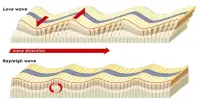Mechanical resonance is the tendency of a mechanical system to respond with greater amplitude when the frequency of its oscillations is closer to the system’s natural frequency of vibration (resonance frequency or resonant frequency) than other frequencies. It is a phenomenon that occurs when a mechanical system is subjected to an external force or vibration with its inherent frequency. It can induce intense swaying motions and potentially catastrophic breakdown in poorly constructed structures including bridges, buildings, and airplanes. This is a phenomenon referred to as resonance disaster.
In layman’s terms, if you push or vibrate anything at the exact appropriate frequency, it will begin to vibrate more and more, occasionally to failure. This is like pushing someone on a swing: if you push at the appropriate time, the swing will go higher and higher.
Occurrences
Resonance occurs in a variety of mechanical systems, including bridges, structures, equipment, and musical instruments. For example, glass may fracture if exposed to the appropriate frequency of sound waves, or a suspension bridge may wobble excessively if winds match its natural frequency.
Avoiding resonance disasters is a major worry in every building, tower, or bridge construction project. To adjust the response at resonance, the Taipei 101 building uses a 660-ton pendulum (a tuned mass damper). The construction is also intended to resonate at a frequency that does not normally occur. Buildings in seismic zones are frequently designed to accommodate for the varying frequency of expected ground motion. Engineers building engine-powered items must ensure that the mechanical resonant frequencies of the component elements do not coincide with the driving vibrational frequencies of motors or other strongly oscillating parts.
Many resonant items have many resonance frequencies. Such things will vibrate easily at certain frequencies but less so at others. Many clocks retain time using mechanical resonance in a balance wheel, pendulum, or quartz crystal.
Understanding mechanical resonance is critical in engineering to avoid unintended consequences like structural failure or excessive vibrations. Engineers build structures and machinery to reduce the possibility of resonance by ensuring that their natural frequencies do not coincide with potential external vibrations or forces. Damping methods can also be used to disperse energy and lower vibration amplitude at resonance frequencies.
















